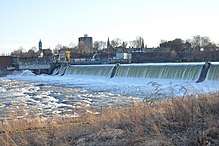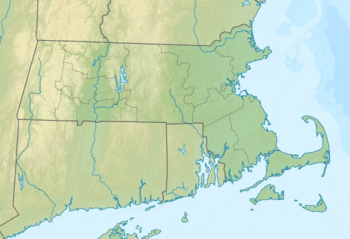Holyoke Dam
| Holyoke Dam | |
|---|---|
 Holyoke Dam during spring thaw | |
 Location of Holyoke Dam in the western Massachusetts, USA | |
| Country | United States |
| Location | Hampden County and Hampshire County Massachusetts |
| Coordinates | 42°12′49″N 72°36′06″W / 42.21361°N 72.60167°WCoordinates: 42°12′49″N 72°36′06″W / 42.21361°N 72.60167°W |
| Purpose | Power, regulation, industrial |
| Status | Operational |
| Construction began | 1895 |
| Opening date | 1900 |
| Owner(s) | Holyoke Gas & Electric |
| Operator(s) | Holyoke Gas & Electric |
| Dam and spillways | |
| Type of dam | Granite gravity |
| Impounds | Connecticut River |
| Height (foundation) | 30 ft (33.5 ft while rubber bladder is inflated) |
| Length | 1,020 ft (310 m) |
| Elevation at crest | 94.6 ft (28.8 m) |
The Holyoke Dam, also referred to as the Hadley Falls Dam, or Hadley Falls Station is a granite dam built to produce hydroelectric power in tandem with the Holyoke Canal System at Hadley Falls on the Connecticut River, between Holyoke and South Hadley, Massachusetts.[1]
The current dam is the third structure to be built across the Great Falls at South Hadley. [2]
Background

The river between Holyoke and South Hadley contained what was known as the "Great Falls" a natural 53 ft drop in the river approximately 86 miles upstream of the Atlantic ocean. Following the success of the textile mills in the planned industrial city of Lowell, Massachusetts a group of investors sought to imitate this city along a natural curve in the Connecticut River. George C. Ewing a sales representative of Fairbanks and Co. marked what was then known as West Springfield, as a site for future development. By the fall of 1847 Ewing, acting as land agent for the investors involved, obtained possession of 1200 acres of land on the right bank of the Connecticut river at Hadley Falls for the purpose of establishing an industrial city. A charter was obtained from the Massachusetts Legislature in the winter of 1847-1848 under the name of the ‘Hadley Falls Co.’ with a capital of four millions of dollars. In the summer of 1848 a timber crib dam was constructed across the Connecticut River at the Great Falls.
First Dam

Constructed using a timber frame the dam was filled with rubble and stone and was completed in a matter of months. Upon completion the gates were closed at 10AM and the reservoir behind the dam began to fill. As recorded in Harper's Weekly, “The engineer took great pride in his work, and when it was finished, and the gates shut down, he is said to have irreverently exclaimed: ‘There! Those gates are shut, and God Almighty himself can not open them!’” By noon the timber dam had sprung massive leaks, and the footing began to show signs of weakness at 2:00PM. The dam had not been properly secured to bedrock and at 3:20PM the dam gave way and a torrent of water, logs and debris headed downstream towards Chicopee, Massachusetts. A foreman sent a telegram to investors in Boston which read, "3:20 p.m., your dam has gone to hell by way of Willimansett."[1]
See also
References
- 1 2 "— Holyoke's Dam Disaster of 1848". 17 February 2012.
- ↑ "LIHI Certificate #89 - Holyoke - Low Impact Hydropower Institute". lowimpacthydro.org.
External Links
- Hydro Electric Development, a pamphlet produced by the Holyoke Water Power Company during its upgrade of electrical infrastructure at the dam in 1951
